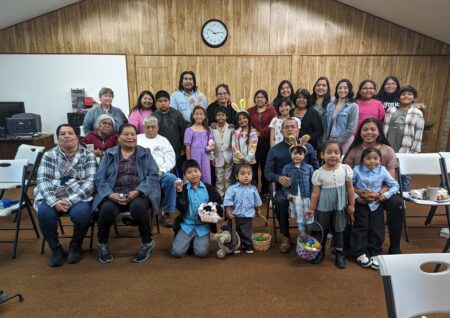ABHMS training series empowers Indigenous leaders for a vibrant future in Native American ministries
VALLEY FORGE, PA (10/10/2024)—In fall 2024, Native American Ministries of American Baptist Home Mission Societies (ABHMS) launched the Native American Leadership Training Series (NALTS) to equip Indigenous ministry professionals with new skills in a culturally sensitive way. Native American churches face specific challenges that require context-specific solutions. Rather than providing cookie-cutter remedies, NALTS adapts TENx10 resources offered by a consortium led by the Fuller Youth Institute. The Tenx10 program “seeks to help faith matter more for 10 million teenagers in the next 10 years in the spirit of John 10:10.”
Religious disaffiliation has been on the rise among young people, with a growing number identifying as religiously unaffiliated. Approximately 36 percent of Americans aged 18–29 years are religiously unaffiliated. This figure has remained relatively stable over the last few years but marks a significant increase compared to previous generations.
According to NALTS participant Monique Prigmore, a youth ministry leader at Bethany Baptist Church in Clarksdale, Arizona, on the Yavapai-Apache reservation, trends in Native American ministries are similar as far as teenagers and young adults are concerned. Young people tend to fall away from church even after being deeply engaged as children. “Our youth start out coming to church on their own, without parents or grandparents. It would be just children coming for breakfast and for Sunday school, and they kind of grow and attend maybe five to 10 years. And when they hit early teens, they usually fall away.”

Members of the Bethany Baptist Church congregation at Eastertime. The church is in Clarksdale, Arizona, on the Yavapai-Apache reservation.
The shortage of Native American pastors remains a significant issue in 2024, particularly within Native American communities associated with American Baptist Churches USA (ABCUSA). “Currently, 20 percent of Native American ABCUSA churches do not have a pastor,” said Ben Sullivan, national coordinator for Native American Ministries at ABHMS. According to Sullivan, this shortage is partly due to long-standing challenges related to Western-centric approaches to theological training, which may not resonate with the cultural values and traditions of Native communities.
Additionally, financial support is a critical issue for many Native American pastors. The economic realities of ministry work and the expectation of potentially separating from one’s family and community make it a less viable option for many. This combination of financial constraints and the cultural importance of staying close to one’s community creates a barrier to more Native Americans entering pastoral roles.
“Even with the financial support through ABHMS, many of our pastors don’t make enough salary to sustain a living wage. So, a lot of them are bi-vocational, and this doesn’t give the pastors room to pursue further education and training without outside assistance,” commented Sullivan.
As part of NALTS, Sullivan has adapted the TENx10 resources to benefit a cohort of ten Native American leaders: five youth leaders and five support persons from five churches. The resources provide methodologies for developing a focus on discipleship, church leadership, and a renewed emphasis on youth ministry. Part of that focus is based on developing strong mentorship programs and relationships.
“[Young people] begin to transition from high school either to college or to the workforce or other things that they are encountering in life. Possible relationships and moving away from their family dynamic, their parents’ dynamic. All those transitions are factors in how youth end up walking away from the church,” explained Sullivan.
The plan for the 2024 NALTS cohort includes the participants composing a five-sentence statement of identity and belonging for youth for each church in October; developing a youth ministry plan in November that assesses their environment, looking at their strengths, weaknesses, opportunities, and barriers; and evaluating the TENx10 resources by the end of 2024.
Sullivan underscored that the Native American ABCUSA churches are all quite different, with various historical trajectories, contexts, and membership. Some churches have many young adult members, while others are adult oriented. This further requires the resources used in NALTS sessions to be very versatile. “But people know who they are. They know their church, they know their community, they know their tribe. I think that we’re always adapting, bringing culture and faith together,” said Sullivan.
Prigmore expressed her appreciation for NALTS as her church is generating ideas to engage teens and young adults. “For example, traditional church events aren’t able to attract that age group. Egg hunts and traditional hymns are not fun for 13-year-olds. We have to figure out what a teenager versus a young adult wants. And it has to come from us and from our community. And this [NALTS] program isn’t just like, ‘Here, try this.’”
There are plans to recruit a further five churches for the 2025 NALTS cohort. The program offers an exciting opportunity for collaboration and innovation that comes from within the Native American community.
“We know that healing can only come from Christ and our relationship with Him, but we have not been able to cross that barrier of healing yet. We know that all things are possible in God. and so, this course lets us show others that there is hope, and that God is providing us a glimpse of something tangible to do,” said Prigmore.
ABHMS’ Native American Leadership Training Series is made possible by the generous support of readers like you. Give to The Beloved Community Campaign today to support Native American Ministries.
By Rev. Dr. Anna Piela, ABHMS senior writer and associate editor of The Christian Citizen

